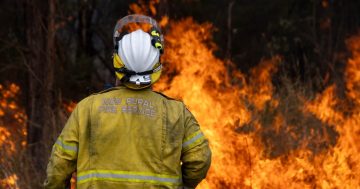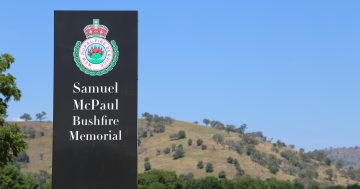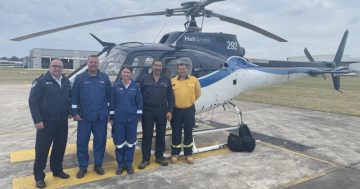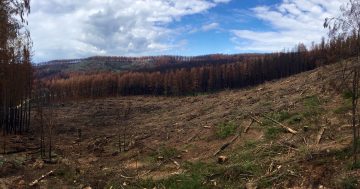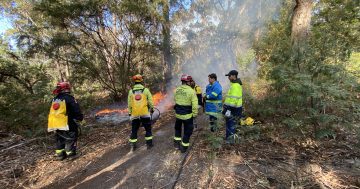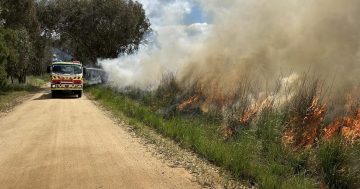
The Currowan Fire burning along the Kings Highway, west of Batemans Bay. Photo: Ulladulla Fire and Rescue.
More resources, compulsory clearing of land and more aggressive hazard reduction burning are among the 76 recommendations to be adopted following the publishing of an independent report into the past summer’s bushfires in NSW.
These recommendations include landowners in some areas being legally required to ensure their properties are safe by clearing land and conducting hazard reduction burns.
The NSW Bushfire Inquiry also identified climate change as a key driver of worsening bushfire conditions.
The inquiry received 1967 submissions following the devastating bushfires that destroyed homes and land in large parts of regional NSW, including hardest hit areas near Cobargo, Bega, Batemans Bay and Braidwood where large out-of-control bushfires burned between the end of November 2019 through to February 2020.
“There are important firefighting enhancements needed,” said the NSW Bushfire Inquiry report. “More emphasis on getting fires out early; improved backburning protocols; training and information around heavy plant use; the right mix of aerial firefighting assets; and increased aerial night firefighting.”
The report also said major long-term changes are needed.
“We need to push available technologies harder, especially fire science, remote sensing, data science and artificial intelligence to equip us better to understand what happens during a bushfire and respond more quickly,” the report stated.
“Fires of this kind are hard to suppress regardless of how well prepared fire authorities are, and the community needs to be physically and mentally prepared.”
The 466-page report was accepted by NSW Premier Gladys Berejiklian who said her government would adopt all 76 recommendations.

A resident of Tomakin surveys the sky on New Year’s Eve 2019. Photo: Cath Blythe.
The inquiry also found that hazard reduction burning will become less effective as fire seasons worsen and that NSW needs to increase training for emergency services personnel and bolster aerial firefighting resources.
Nighttime water bombing and strategies to protect fauna and wildlife were also recommended.
The six-month inquiry was led by former NSW Police Deputy Commissioner Dave Owens, and former NSW Chief Scientist Professor Mary O’Kane.
Member of the Conjola Community Recovery Association and former ACT Emergency Services Agency commissioner, Peter Dunn, also reinforced the need for resourcing to prioritise early fire detection.
“As climate change supercharges bushfires, emergency services also need more resources,” he said.
“Communities in the climate change firing line also need support to stay safe and connected during a bushfire. The NSW and federal governments should establish and fund permanent community resilience hubs in every local government area.”
READ ALSO: Six months on, bushfire scars remain
These comments were echoed by NSW Rural Fire Service Commissioner Rob Rogers who said the report goes a long way to providing answers to what worked well, but he admitted more could be done to keep bushfires from becoming out of control.
“As the report highlights, we have learnt from previous events, but the season of 2019-2020 challenged conventional assumptions and tactics, and the way we prepare for and respond to extreme events,” he said.
“We are already working on improvements, including enhancing the way we detect and monitor fires, and how we can respond quickly to keep fires as small as possible.
“We are also implementing changes to further improve the way we deliver information to the community, especially in border areas. And we are continuing to focus on important mitigation work that can reduce the bushfire risk to NSW communities.
“The report highlights the incredible work of our volunteers, our partner agencies and the community working together, and it’s important to recognise that being prepared for extreme fire events isn’t just a job for firefighters or government, but for everyone in the community.”

The Moruya River and surrounding areas were severely impacted by bushfires in January and February 2020. Photo: Alex Rea.
Former Fire and Rescue NSW Commissioner and Climate Council member Greg Mullins said the NSW Government needs to urgently step up emissions reduction efforts.
“Immediate steps the NSW Government can take to drive down emissions include rejecting all new coal and gas projects such as Santos’ Narrabri Gas Project and accelerating its net-zero plan to create clean, long-term jobs in sectors such as renewable energy,” he said.
“The conditions during the past summer were horrific; worse than anything I’ve seen in almost 50 years of fighting fires. I saw flames running over mown grass. On days of catastrophic and extreme fire danger, hazard reduction makes no difference at all.”
You can read the Final Report of the NSW Bushfire Inquiry on the NSW Government website.
The Royal Commission into National Natural Disaster Arrangements continues with recommendations and findings expected later this year.









